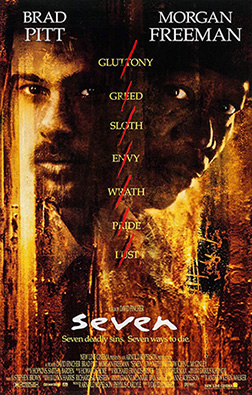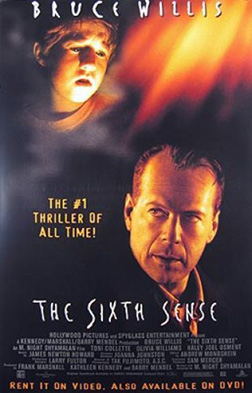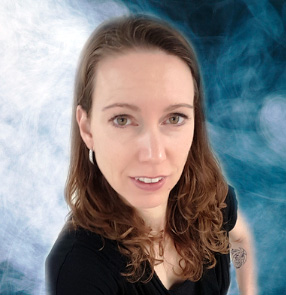
ho doesn’t love a twist ending? The fantastic ones often win awards and keep people talking for years.
When writing, how do you present the twist ending, so it has the biggest payoff for your readers? To figure this out, let’s look at two very different hit movies that had brilliant twist endings: Se7en written by Andrew Kevin Walker and The Sixth Sense written by M. Night Shyamalan.
First, in case you’ve never seen the movies, or it’s been a while, here are quick summaries (includes spoilers):
Se7en

Se7en stars Morgan Freeman as retiring detective, William Somerset, and Brad Pitt as David Mills, his rookie replacement. The movie takes place in a city overcome with heinous crime, and Somerset and Mills soon discover they are tracking a murderer who’s basing his kills on the seven deadly sins.
Somerset and Mills try to find the killer before he gets through all seven sins; but the killer, John Doe (played by Kevin Spacey), turns himself in with Somerset and Mills aware of only five deadly-sin killings. John Doe claims he will show the detectives the whereabouts of the final two bodies; but if they don’t accept his deal, he’ll plead insanity.
The twist ending: Mills’s wife and John Doe are the final two victims, finishing the seven killings.
The Sixth Sense

The Sixth Sense opens with Dr. Malcolm Crowe (played by Bruce Willis) and his wife celebrating an award Malcolm has won for his work as a child psychologist. Their celebration is interrupted by a former patient, Vincent Gray, who claims Malcolm failed him. He shoots Malcolm, then commits suicide.
Set in Philadelphia, The Sixth Sense follows Malcolm, as he works with young Cole Sear to uncover a haunting secret that he’s too afraid to tell anyone. Malcolm is obsessed with helping Cole because he exhibits the same disturbing behaviors as Vincent Gray did when he was Cole’s age.
The twist ending: Malcolm Crowe is dead the entire time he’s helping his young patient.
“Se7en uses repetition to establish a pattern, and The Sixth Sense uses point of view.”
The Set-Up
M. Night Shyamalan and Andrew Kevin Walker have each set up the twist ending differently: Se7en uses repetition to establish a pattern, and The Sixth Sense uses point of view.
Even if you haven’t seen the movie Se7en, you can guess what the pattern is. Detectives Somerset and Mills find victims who have been judged by John Doe to have committed one of the seven deadly sins. First, gluttony. Then greed, sloth, lust, and pride, leaving the victims of envy and wrath yet to be discovered.
This set-up is methodical which can sometimes lead to boredom, but Walker intersperses two mini-twists that keep viewers glued to their seats: 1) The detectives discover John Doe’s apartment, and a chase ensues; and 2) John Doe turns himself in.
In The Sixth Sense, Shyamalan uses the opening scene, where Malcolm is shot, as a prologue. He sets the stage with this big, dramatic opening. The next scene is Malcolm sitting outside Cole’s house, making notes and waiting for Cole. We’re wondering: is this before or after he was shot?
We learn the movie is taking place after Malcolm was shot when we see him flipping through his notes which show the date as 1998 for Cole Sear and 1989 for Vincent Gray. From here, we continue to follow Malcolm and Cole, as they build a relationship. In contrast, we see Malcolm’s wife become distant, he believes, because he is spending so much time with Cole.
“Suspense is created by showing the reader something the protagonist doesn’t know, but the element of surprise often provides no warning to the reader.”
The Twist
Surprise is a writer’s most prized weapon when it comes to the twist ending. Suspense is created by showing the reader something the protagonist doesn’t know, but the element of surprise often provides no warning to the reader, or in these cases, the viewer. You can use suspense to build toward surprise, but some of the best twist endings appear to reveal nothing beforehand—while still making sense in the world of the story.
The endings to both Se7en and The Sixth Sense are unexpected—unless your blabbermouth friends who saw the movies before you couldn’t help themselves from giving away the endings. Where Se7en uses the two mini-twists to build suspense towards the end of the film, The Sixth Sense uses subtle hints. The biggest of which is when Cole tells Malcolm he’s ready to tell him his secret: he sees dead people.
Breaking the Pattern
There are two victims remaining in Se7en—their sins are envy and wrath—and John Doe has agreed to lead the detectives to the bodies. Based on the pattern established throughout the film, we suspect Somerset and Mills are being led to two dead bodies.
But of course, it wouldn't be a twist ending if this is how the film ended. So, instead of John Doe leading the detectives to two dead bodies, a mysterious delivery van makes its way to the location where John Doe led Somerset and Mills. John Doe tells Mills how jealous he is of him and how he visited his wife. Cue envy.
Mills is confused by what John Doe says and thinks he’s trying to distract him. Meanwhile, Somerset has received a box from the delivery man and opens it to discover the head of Mrs. Mills. Cue wrath.
Somerset runs to Mills and Doe. Doe has already implied he raped and murdered Mills’s wife; and Somerset, having confirmation Tracy Mills is dead, tries to get Mills to walk away. Mills’s wrath overcomes him, and John Doe becomes the final seven-deadly-sin victim, leaving viewers with their mouths gaping. Of course, no one expected Mills to kill the seventh victim.
Exposing Reality
After Malcolm Crowe is shot, The Sixth Sense continues the movie from Malcolm and Cole’s points of view. Malcolm doesn’t know he’s dead, and neither do viewers. Cole hints at this when he tells Malcolm he sees dead people, but Malcolm doesn’t react regarding his own death. He’s only worried about Cole and how he can help him.
There are key scenes where Malcolm interacts with his wife. She seems cold and distant and won’t talk to him. He thinks it’s because of all the time he’s been spending at work, helping Cole. After Cole tells Malcolm his secret, he tells Malcolm he knows how he can talk to his wife, so she will listen—when she’s sleeping. Cole knows Malcolm is dead. Part of his secret is that the dead people he sees often don’t realize they’re dead, and Malcolm is no exception.
As the movie builds to its climax, Malcolm returns home to find his wife sleeping while their wedding video plays, and he takes Cole’s advice. He starts talking to her, and the wedding ring she’d been clasping in her hands falls to the floor. It’s Malcolm's ring. He looks at his hand. His ring isn’t there, and the truth is exposed. Malcolm’s mind flashes back to all the scenes where we were only shown his point of view, and Malcolm (and the viewers) see then that he is dead.
Your Assignment . . . Should You Choose to Accept It
As a writer, how can you create a twist ending at the level of Walker’s or Shyamalan’s? How can you shock your readers and leave them wanting more?
Since twist endings are so interesting, through studying them, there is a definite method to approaching them as a writer. Here’s what you can do:
1) Figure out what you want the twist to be.
I’ve heard many writing coaches and writers say it’s best to know your ending before you start your story, even if you don’t plan to have a twist ending. It may seem counterintuitive to know the ending before you start writing. But, remember, you’re the creator here, not the reader. If you know how you want your story to end, then you can plan your tactic for making sure it’s a surprise to your readers.
2) Determine your set-up.
Walker and Shyamalan use two different methods of setting up their twist endings. There are other ways to create twists. Examine some of your favourite twists. (Other examples of popular novels/movies with twists: Gone Girl, The Girl on the Train, Fight Club, Identical, and Big Little Lies.) Did the authors use a pattern to get readers expecting something that wasn’t coming? Did the perspective add to the twist? Or did they use another strategy altogether?
I recommend starting with a favorite twist in a book or movie you love because you will enjoy the work of analyzing it. Movies are great for dissecting because they are typically over in a couple of hours. You can watch the movie, then take a few days to dig deep and figure out what made the twist so spectacular. Then try this method in your own work.
3) Think outside the box.
The best twist endings are, of course, a total surprise to your reader. Some astute readers may guess what’s coming; but if you want to catch as many people off guard as you can, go with something unpredictable.
As my final tip, I want to encourage you to brainstorm many more ways you can create your twist after you’ve decided on it and the set-up to get there. This exercise will help you flesh out your ideas to make sure they will achieve your goal of surprising your readers. Talk your twist out with a trusted friend. Are your original ideas still the most unpredictable? How can you make them more unpredictable?
Leave your ideas for a few days, then go back to them. We are often the most critical of ourselves, so you may think your twist isn’t surprising enough when you go back to it. Don’t throw those ideas out. You might be able to tweak them so they work, or maybe you’ll come up with more that work better. Here is where beta readers or trusted critique group members will come in handy. They can read your novel or screenplay and let you know if they were surprised or not.
Whether you choose a pattern-style set-up like Se7en or an alternate point of view like The Sixth Sense, remember that surprise is your best weapon when it comes to the twist. Readers (and movie-viewers) love twist endings. The research and work required to create them is worth the payoff.
After all, wouldn’t it be fun if your novel or movie was the topic of conversations that included the line, “Don’t you dare spoil the ending for me!”
*

After spending almost twenty years in the public accounting industry, Michelle sold her accounting practice to spend more time with her family and pursue her dream of writing. In 2017, she published Keep More Money, a guide to help business owners find a trustworthy accountant. Realizing that she wanted to write fiction, in 2018, Michelle published Murder Audit, her debut novel and book one in the Cynthia Webber financial thriller series. Book two in the series, Auditing Jane Doe, is currently available for pre-order. Find out more about Michelle on her website www.michellecornishauthor.com or her Amazon author page.